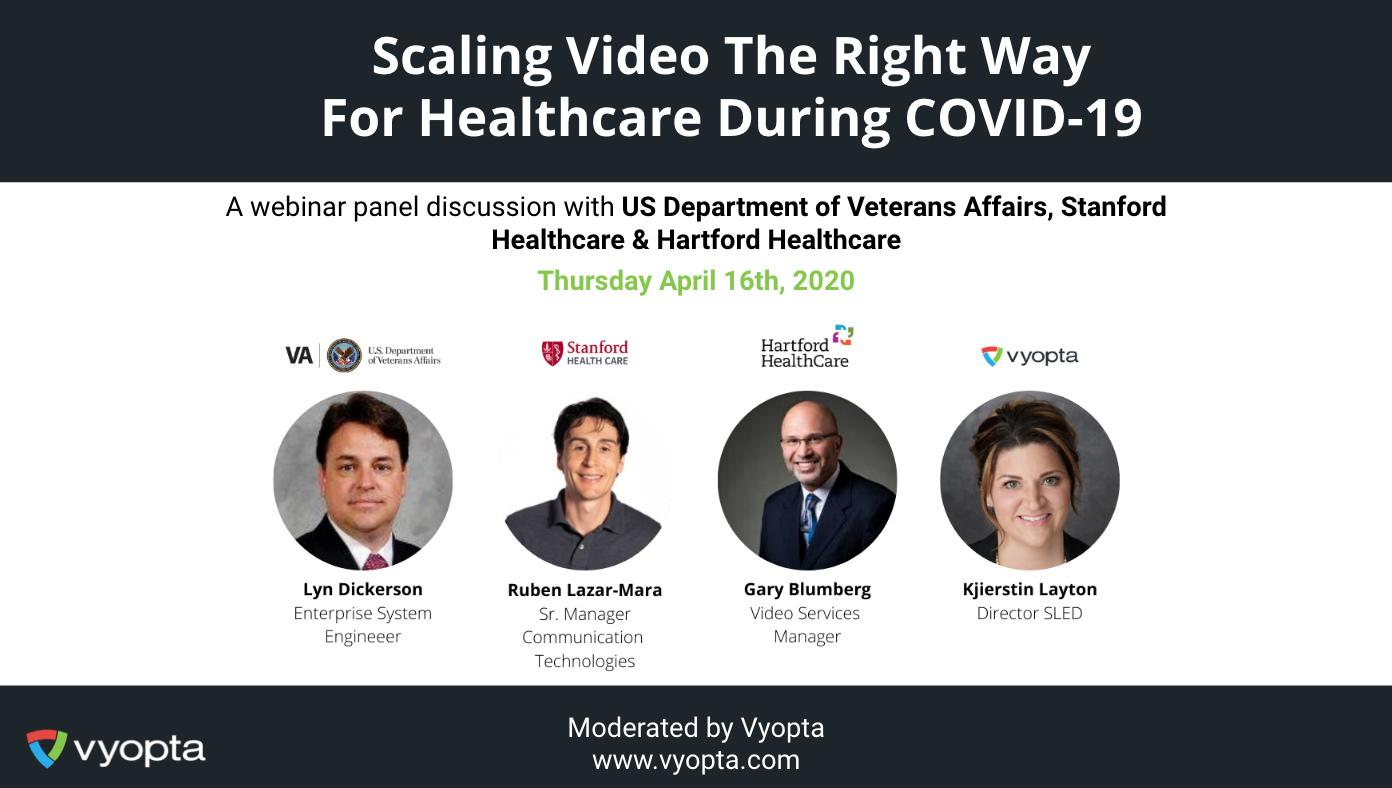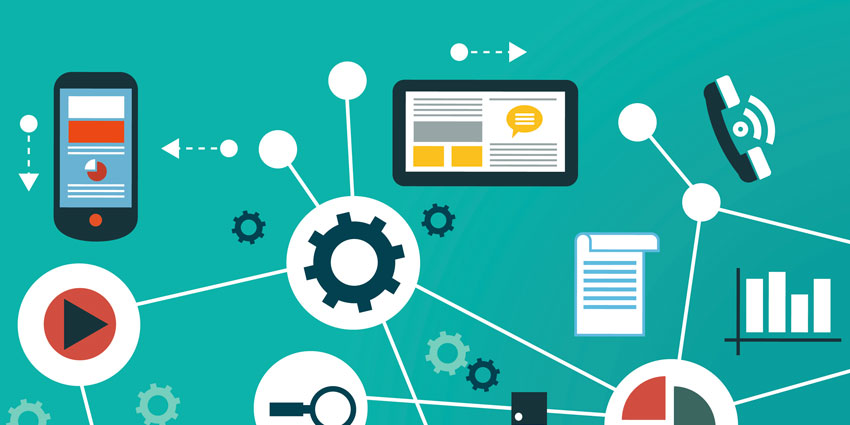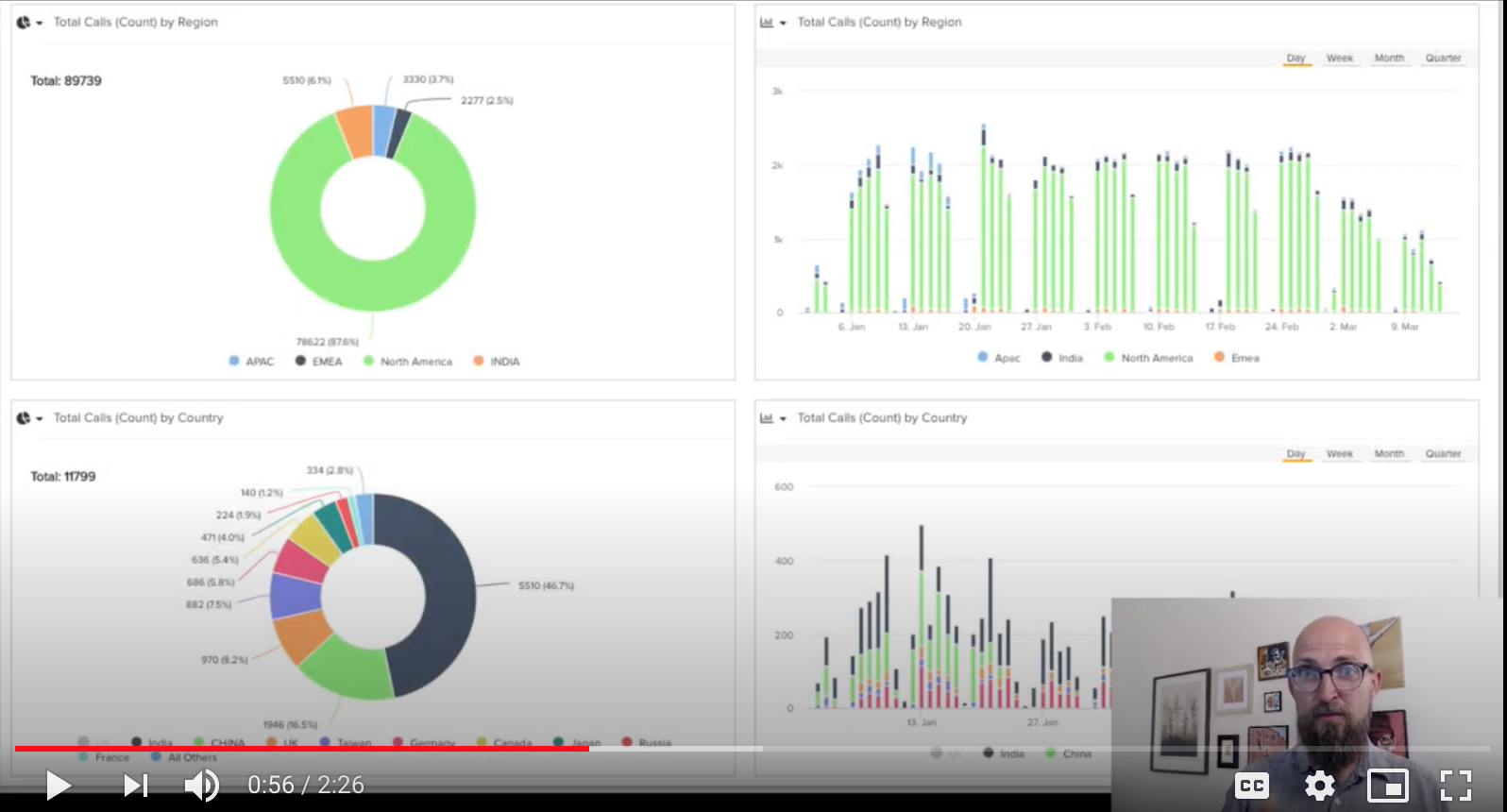On Thursday, April 16th, Kjierstin Layton from Vyopta, hosted a webinar panel discussion with Healthcare experts including Lyn Dickerson, Senior Engineer with the US Department of Veterans Affairs, Ruben Lazar-Mara, Communications Manager with Stanford Healthcare, and Gary Blumberg, Video Services Manager with Hartford Healthcare. The panel was focused on how they have dealt with the changes that coronavirus has brought to telehealth and healthcare industry.
Kjierstin Layton began the discussion by emphasizing how critical unified communications is right now in the world due to COVID-19, especially in healthcare. She reviews how Vyopta can give you insights from complete visibility across collaboration and mentions that Vyopta is offering free solutions during the pandemic. Our Vyopta customers are seeing massive increase in usage due to COVID-19. Lyn Dickerson with the U.S Department of Veteran Affairs chimes in and states, “Our call volume has gone from 325k minutes of usage per day to over 1.7 million minutes a day.” while Gary Blumberg with Hartford Healthcare mentions, “We increased ability by 600% over the past two weeks to support new telehealth volumes.” This is massive amounts of data that this volume has increased to and it that shows real time capacity planning is a must.
How has COVID-19 impacted your organization operationally?
Gary discusses how they are wanting to be prepared to handle the massive increase in calls. One of things that Hartford Healthcare’s telecommunications team did was take a look at people that were dialing externally and strip off those numbers that were calling externally and force them to the inside. With the new mandate being that all meetings now have to be virtual it is extremely important that we are prepared. Ruben with Stanford Healthcare mentions that virtual visits grew a large amount and they noticed departments that required this technology to provide their duties as well, so getting them onboard and monitoring all of those solutions is a main pain-point that Vyopta helps us with. Ruben mentioned, “The main thing that is helping us along the way through all of this is that we have visibility into how the workflows are impacted by infrastructure, and we have visibility where our numbers are, due to a solution like Vyopta.”
In your role, what are some of the new demands that have come forth with COVID-19?
Lyn mentions that prior to COVID-19, they really were not prepared for the large amount of usage that they have received – the biggest demand has been time. Lyn states that, “We are on top of their environment more so than ever and we are looking through our data out of our Vyopta Analytics Data Solution. We have also leveraged the Vyopta Real Time Monitoring Solution, and with these tools we are moving our environment to meet the demands that we’ve seen.” Lyn then gives an example of one element where he states, “We were running a Pexip infrastructure of 64 nodes before COVID-19 with an average of 800 calls throughout the day and 325,000 minutes, and are now up to 1.7million minutes. In fact, we are now at 177 Pexip nodes, which is tremendous workflow. We are scaling up Pexip services while at the same time monitoring Cisco endpoints and infrastructure.” He also mentions that, “We were able to isolate where we were seeing stressors from the data that we were able to extract from our Vyopta Analytics. We rely on that data quite a bit.”
What technologies are being required now? How is meeting technology playing into this?
Gary speaks on how important it was to show actual data to back up his numbers to the new CTO at Hartford Healthcare and how that is why Vyopta came into play for his position. He states, “I knew that I needed to back up my answers to the new CTO and I was able to easily do this with Vyopta Analytics.”
What are important factors that influence the patient/provider or remote healthcare worker experience?
Lyn mentions that the VA is developing a survey with the Atlas program to get immediate feedback of how the veteran felt with the call and how the experience was. The VA is sending a tremendous amount of our employees to work remotely and a lot of them are doing this for the first time. Lyn states, “One importance we have seen with the detailed call records that we received from Vyopta is that we have seen our providers are using it over other free commercial solutions. We know that our care givers are using our products and we are able to have that data to back it up from the analytical side.” Ruben brought up a good question on how do we deal with this plethora of interfaces? He states that Stanford is looking to standardize the user interface. Gary agrees that Hartford Healthcare had to standardize as well.
What positive outcomes do you see coming out of COVID-19?
Lyn describes how much the VA has stressed Pexip and Cisco to all ends and they will be at almost 300 nodes by this week. The VA has learned how to consume immense amounts of video and do a good job at it. He states, “This weekend we are going to duplicate our environment over to an AWS commercial space.” Lyn states the silver lining of COVID-19 was it has made them ready with a complete AWS deployment and it has proven that we can do what we thought we could all along and that video has a place in healthcare. Ruben learned it is very important to have a solid relationship with vendors and to leverage all of their technical knowledge. It’s all about the patient experience and that will have to make up for the lack of social interactions without the physician in place.
Want to watch this webinar?

Taylor Tachovsky is a passionate marketing coordinator with 4+ years of brand building experience directing campaigns and improving company results through social media content, strategic marketing campaigns, event planning, and outreach expertise. She has experience in many different branches of business including events, logistics, communications, and public relations. She holds a B.S in Management Communication from North Dakota State University and writes about topics related to technology and the event marketing industry.







